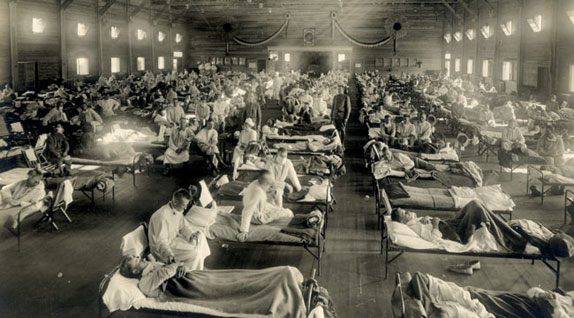Exactly 100 years after a global outbreak of Spanish influenza infected 500 million people around the world and killed up to 50, the flu in what is considered the deadliest outbreak in the world is back.
It began on December 4 on the island nation of “Mizzou”, off the coast of North America.
Just 24 hours later, it had reached the US and Canada. It wasn’t stopping. The flu is airborne, meaning it is transmitted through the air. In the same 24 hours, it came into Nigeria through one of the international airports.
Air travel means a lot of contacts—many people unknowingly in contact with the one person carrying the flu virus.
Two days into the outbreak, Nigeria upped its response to “activation level 3”.
But don’t panic. It is not an actual outbreak. There is no actual virus, and this is just an internet training exercise, according to the Nigeria Centre for Disease Control.
No personnel or goods were deployed for response. No daily activity was affected, says the centre.
The exercise took place only within its emergency operations centre (EOC) in Abuja and some 40 other similar centres around the world that make up a global network of health EOCs.
The World Health Organisation’s global EOC coordinated the Spanish flu “pandemic” in a simulation to assess how countries respond to an actual outbreak. ‘
It is the first global simulation. Two others at national level have been conducted in Jordan and Senegal.
Learning what to do
In the interactive training, the WHO EOC emails national EOCs with new levels of risks from the flu outbreak on Mizzou.
Each EOC has to respond to the new risk level with an incident management plan.
It means what do you do as an institution, unit or individual in the event of an outbreak.
The plan tells what level of outbreak you are dealing with, what level of resource you should be mobilizing, who you should be working with, what kind of information you should be giving out to the public.
For the simulation, participants at the NCDC’s Incident Coordination Centre took part, alongside the ministries of health, environment and agriculture and rural development, and the country offices of the WHO and the US Centre for Disease Control. A representative from Public Health England evaluated Nigeria’s response.
On the second day of the “outbreak”, with the flu already declared to have flown into the international airport in Abuja [recall Ebola flew into the Lagos airport], the Nigeria response was amped up to “activation level 3”.

The EOC got fully in charge
Every activity in the institution slows down; all resources are channelled to the outbreak. Even non-technical staff are co-opted into the outbreak response.
The EOC routinely meets once a week. But at stage 3, it meets nearly every day.
The race was on. The flu is airborne. In 1918, in the heart of World War I, close quarters and massive troop deployments aided its spread. Otherwise healthy populations were infected. The incubation period—the time taken for the disease to manifest—shortened. In some people infected, it took mere hours before they died.
The simulation figured that into a pandemic scenario, with the disease already in Nigeria at the end of the second day of simulation.
At that point it meant danger for all, and it had to move fast, because the influenza can be transmitted through the air.
It came in through the international airport. The contacts are a lot. The incubation period is short. With that, it is a very dangerous situation. Based on that, things escalated to Level 3 [skipping all levels before]. When it gets there, even the president has to pay attention.
Evaluators from Asia, North America, Europe and Africa watched how each EOC in the simulation performed in real time—and measured their performance against what is expected from existing procedures.
“The exercise offers participants a way to test their plans and capabilities in a realistic environment to gain an in-depth experience that can best be achieved by practice,” NCDC chief executive officer Chikwe Ihekweazu said in a notice before the start of the simulation.
“This experience will identify gaps and areas for opportunity that will ultimately help in the assessment and improvement of member states’ readiness to respond jointly and effectively to a global public health emergency.”
What to know about the flu
The flu pandemic came to be linked with Spain because it received greater attention after it spread from France to Spain.
Two types of flu viruses exist—A, B and C—and cause respiratory tract infections in human.
Type A has 15 subtypes, some of them found in pigs, humans, horses or birds. Scientists have come to know the 1918 pandemic was caused by the H1N1 virus, which continued to circulate as a seasonal virus worldwide for 38 years after WW1.
The flu virus can pass from humans to animal and vice versa.
In other cases, genetic particles of the virus from birds, pigs or human get mixed to produce rare subtypes that are more deadly.
The idea of a worldwide outbreak comes from the expectation that such a mixture will produce a flu that will spread quickly and unchecked in humans when there is no immunity, according to the NCDC.
Both the pig and bird subtypes produce symptoms in humans similar to the human version of the flu virus: fever, inflammation of the lining of the eye, fatigue, lack of appetite, coughing, sore throat, vomiting, diarrhoea, muscle aches.
When untreated, an infection can result in disease affecting several organs.
To diagnose human flu virus infection, particles of the virus have to be isolated in secretions from the throat and nose. But developing countries most times lack the technology. Commercially available rapid tests are less sensitive.
The flu can be treated using antiviral drugs. Oseltamivir, Peramivir, and Zanamivir have been successful in treatment of bird flu. But some resistance has been reported in some flu viruses isolated from humans.
However, bird flu can be prevented in humans by vaccination, though protection is not offered against all strains of the virus.
The NCDC also stresses infection prevention practice, including having people who work with poultry to wear personal protective equipment while working in communities where an outbreak has been reported.
It also recommends having poultry and poultry products well cooked and ensuring good hand hygiene.

 Join Daily Trust WhatsApp Community For Quick Access To News and Happenings Around You.
Join Daily Trust WhatsApp Community For Quick Access To News and Happenings Around You.


